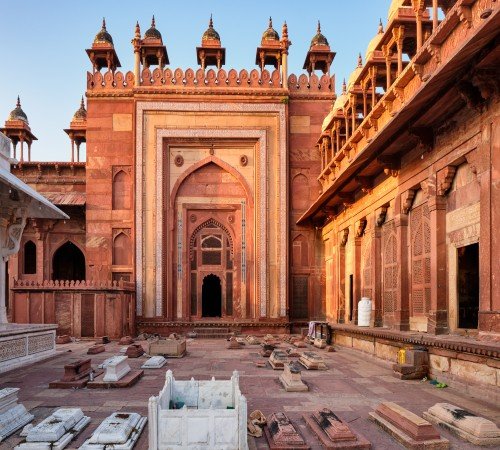Talk to a Destination Expert


No points for guessing the first word that comes to mind when you hear the word Agra – The Taj Mahal alone is worth paying a visit to this city, but it is not the only wonder this city offers to visitors.
There is amazing food, great art, vibrant culture, enticing shopping opportunities, amazing architecture, and much more. From grand forts and mausoleums to sprawling markets and artisanal arts & crafts, Agra is full of adventures and attractions. We’ve selected for you a great list of the best things to do in Agra and places to visit.


There’s is no sight like watching the sunrise on the Taj. It is truly a magical experience when the shimmering golden rays of the dawn sun kiss the sparkling marble, a great time to take capture some awesome shots in the soft light. The translucent marble of the Taj Mahal gradually changes textures from soft pink hues to light orange as the sun rises. The earlier you get to the Taj Mahal, the better. As the day wanes, crowds start swelling, and it gets noisy and crowded. Dawn is the time to be at the Taj Mahal.


The red-stone Agra Fort was the residence of the Mughal Emperor before the capital was moved up north to Delhi. Standing at a towering 100 feet and spread over almost 100 acres of land, the Agra Fort (inaugurated in 1520s AD) is the most formidable of all man-made structures that towers over the city from its elevated perch. This UNESCO World Heritage Site is the second most important historical landmark of Agra after the Taj Mahal. It houses some incredibly beautiful palaces Sheesh Mahal, Jehangiri Mahal, Shahjahani Mahal, and expansive pavilions like the Diwan-e-am and Diwan-e-Khas.


The Itimad-ud-Daulah mausoleum which lies on the eastern banks of the Yamuna River is known as ‘Baby Taj’ or ‘Baccha Taj’ in Persian (also known as “Jewel Box”). It has an interesting backstory. The charismatic Queen Nur Jahan, wife of Jahangir commissioned the tomb in honor of her father Mirza Ghiyas Beg, a minister in the Mughal Court who was known in the court as “Itimad-ud-Daulah” (Pillar of the State). The reason why it is known as Baby Taj is that its architectural blueprint was later expanded to build the Taj Mahal. A must-visit place for lovers of art and architecture.

Out of dozens of Mughal emperors who ruled India for the best part of three centuries, the third emperor Akbar was perhaps the greatest of all Mughals—a visionary, a dreamer, a poet, a philosopher, and a great patron of fine arts. A visit to his tomb in the small town of Sikandra on the outskirts of Agra is one homage you should consider. Completed in 1605 AD and spread over 120 acres, this dark red-stone tomb garden is one of the earliest masterpieces of Indo-Saracenic architecture. The minarets of the Taj Mahal are said to have been copied from here. Sikandra is a classic Mughal architectural wonder.


Some 25 miles from Agra, lies the town of Fatehpur Sikri (UNESCO World Heritage Site) which was founded by Emperor Akbar as his new capital in the late 1500’s and later abandoned when he moved the capital back to Agra. Fatehpur Sikri has everything you need for historical immersion: mystery, legend, tragedy, architectural glory, and lots of beauty. Landmarks we recommend that you should check out: the Jama Masjid (grand mosque), Buland Darwaza (the 50-meter-high towering entrance gate), the tomb of Sufi saint Salim Chishti, and the grand palace of the emperor and his wives.

Mehtab Bagh or ‘Moonlight Garden’ is a garden complex north of the Taj Mahal across the Yamuna River. It is the best place to view not just the Taj Mahal but also the Agra Fort. It was built to provide visitors with pristine views of the Mahal. It aligns in a perfect geometric 300×300 meter square. It’s lush green and perfectly manicured. A great place to enjoy a relaxing evening with a refreshing sundowner. And, the perfect view of the Taj!

Visitors come to Agra for the Taj Mahal, but they stay for the culture and cuisine. One place to immerse yourself in is the Saddar Bazaar known for its leather products, garments, handicrafts, Petha sweets, and traditional eateries. The bazaar has a very popular food street that specializes in a popular snack called “Chaat” with many eateries offering a wide range of savory, spicy, and tangy Chaats. Picture a mesmerizing blend of boiled potatoes, chickpeas, chutneys, samosas, fried dough, and deep-fried dough.

Taj Nature Walk is a public park facing the Eastern Gate of Taj Mahal. Spread over 70 hectares and located only 500 meters from the Taj Mahal, you get great views of the Mahal. It is a quiet part of town with a diverse range of trees and plants. For its lush greenery, it is home to local birds like Orioles, Rose-Ringed Parakeets, Woodpeckers, Kingfishers, peacocks, chipmunks, and butterflies. It has many relaxing walking tracks for a refreshing morning stroll.


The Elephant Conservation and Care Center (ECCC) is a rescue and rehabilitation center established in 2010 by WILDLIFE SOS where some 30 elephants rescued from abuse and exploitation are looked after. Next to the ECCC, lies the Agra Bear Rescue Facility where some 110 sloth bears rescued from all over India are looked after in a natural bear-friendly landscape comprising shady trees, ponds, and green habitation. For wildlife lovers, a visit to these two facilities is a great way to get to see these magnificent animals and spend ethical time with them. Revenue generated from such tourism is used to provide for these animals. So, your visit is for a good cause.


Every month, for five nights only, the Taj Mahal opens for nighttime viewing. This happens on the night of the full moon, two nights before it, and two nights after. But it is no open-for-all entry. Only 8 batches (50 people each) are let in for tours of 30 minutes starting at 10 pm. The last batch ends at midnight, so you’ll have to book your ticket in advance to make sure you get a spot. The experience is worth it.

Parchin Kari (also known as Marble Inlay Art or Pietra Dura in architectural lingo) is the secret behind the magic of the Taj Mahal. Precious stones are inlaid into marble slabs creating stunning visual effects —like paintings in stone. That’s where the Taj Mahal gets its shimmer from. As the sunlight strikes the semi-precious stones, it creates a magical shining effect. It is believed that during the heyday of its construction thousands of Inlay work specialists, assembled from as far as Central Asia and Persia, worked on the Taj Mahal. Their descendants have kept the tradition alive.

One of the oldest bazaars in Agra located near the Jama Masjid, Kinari is every ‘ethnic-shopping’-enthusiast dream. You get so many amazing things at the Kinari Bazaar: handicrafts, leather-ware items, handwoven rugs, cosmetics, traditional garments, sculptures, glassware, bridal jewelry, and ornaments. Even if shopping is not on your bucket list for Agra, we recommend that you take a stroll in the winding meandering little alleys of Kinari bazaar to soak in its old-world charm.

Shero’s Hangout Cafe is a stylish little café that is more than just a place to enjoy a hot beverage or snack. It is a story of triumph in the face of forces of evil. Run by female acid attack survivors, the Café was established by the NGO Chhanv Foundation in 2014. A visit to the Café is a step outside of the tourist bubble and a chance to get to see real-life heroes (Sheroes) and get to know their story. Your visit serves as an encouragement to the females and helps the establishment continue its service.